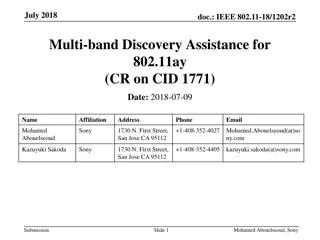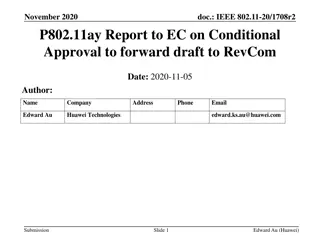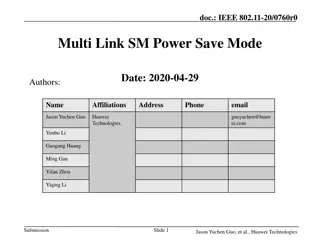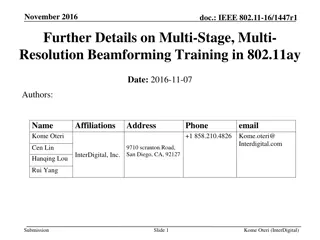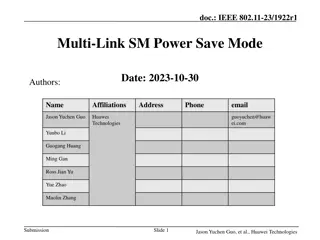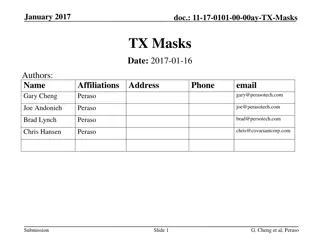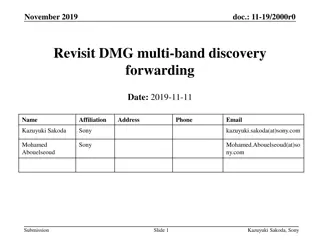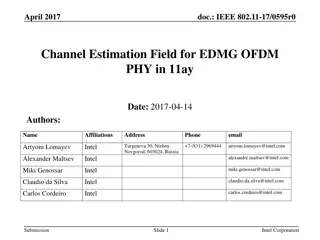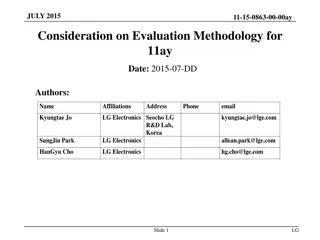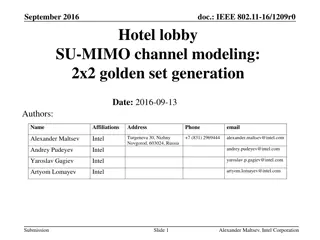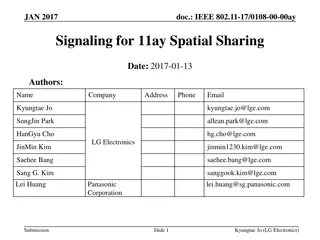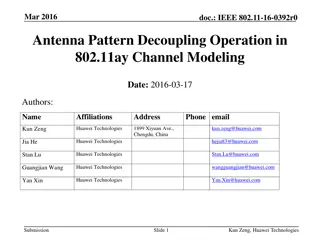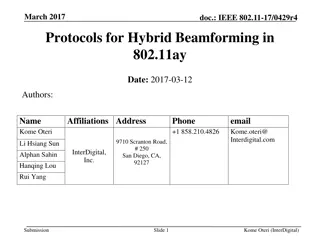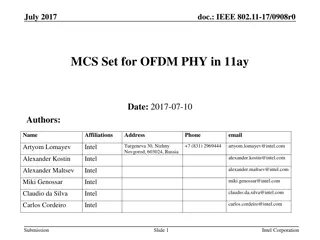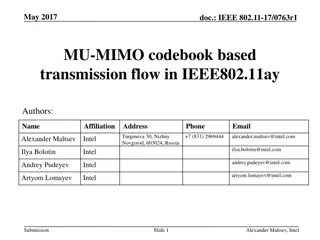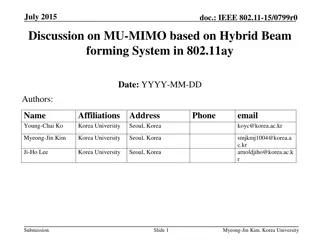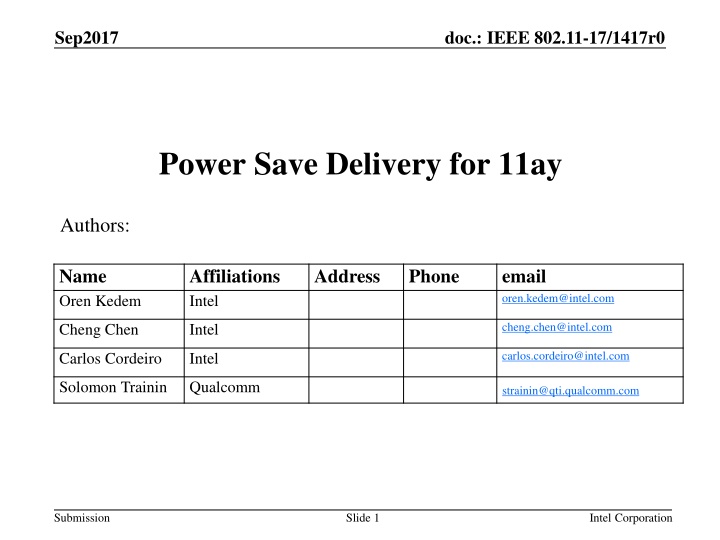
Improving Power Save Delivery for 11ay in IEEE 802.11-17 Standard
Enhance power saving mechanisms for Quality of Service traffic like Voice/Video in IEEE 802.11-17/1417r0 document. Proposed improvements aim to enable devices to save power while delivering critical traffic, addressing limitations of existing mechanisms like Triggered Unscheduled Power Save.
Download Presentation

Please find below an Image/Link to download the presentation.
The content on the website is provided AS IS for your information and personal use only. It may not be sold, licensed, or shared on other websites without obtaining consent from the author. If you encounter any issues during the download, it is possible that the publisher has removed the file from their server.
You are allowed to download the files provided on this website for personal or commercial use, subject to the condition that they are used lawfully. All files are the property of their respective owners.
The content on the website is provided AS IS for your information and personal use only. It may not be sold, licensed, or shared on other websites without obtaining consent from the author.
E N D
Presentation Transcript
Sep2017 doc.: IEEE 802.11-17/1417r0 Power Save Delivery for 11ay Authors: Name Oren Kedem Affiliations Intel Address Phone email oren.kedem@intel.com cheng.chen@intel.com Cheng Chen Intel carlos.cordeiro@intel.com Carlos Cordeiro Intel Solomon Trainin Qualcomm strainin@qti.qualcomm.com Submission Slide 1 Intel Corporation
Sep2017 doc.: IEEE 802.11-17/1417r0 Motivation and Purpose QoS traffic like Voice/Video requires short periodic service. (Typical use case for Voice Traffic is 20-50KB every 20ms). Spec should allow STA to support Voice/Video while maintain power save. 11ac addressed this use case with U-APSD mechanism that is commonly supported by most of Wi-Fi chip vendors. 11ay should enable the STA to save power while delivering Voice/Video traffic. Contribution is a proposal for a suggested improvement on existed 11ad Triggered Unscheduled Power Save mechanism to address the above Submission Slide 2 Intel Corporation
Sep2017 doc.: IEEE 802.11-17/1417r0 11ad Power Save Mechanisms Scheduled Power Save STA and PCP/AP communicate a Wakeup Schedule of cycling between awake BIs and doze BIs. Enable PS cycles in granularity of BIs (>100ms) hence is not suitable for short time doze states. Unscheduled Power Save STA informs the PCP/AP on entering and exiting PS by completing a successful frame exchange with the Power Management subfield in the Frame Control field. Involved with major overhead to communicate PS transitions, hence not suitable for short time Doze states. Scheduled Allocations PCP/AP allocate dedicated SP for STA QoS traffic. SP Allocation is not always guaranteed. Not suitable for CBAP Only (most AP s link access scheme). Above 11ad PS mechanisms are not suitable for STA PS while delivering QoS Traffic. Submission Slide 3 Intel Corporation
Sep2017 doc.: IEEE 802.11-17/1417r0 11ac U-APSD Overview STA designates one or more of its ACs to be trigger-enabled ACs (i.e. U- APSD, Unscheduled-Automatic Power Save Delivery). STA may configure the AP to use U-APSD Via Association procedure or alternatively by sending an ADDTS request per AC. STA using U-APSD shall have the Power Management bit in the frame control field set to 1 for buffering to take place at the AP. STA send unicast QoS-Data/Null frames while in PS-mode which triggers the AP to send the STA its BU. AP sends the BU to STA immediately after the Trigger frame STA must remain awake as long as data is still available. Submission Slide 4 Intel Corporation
Sep2017 doc.: IEEE 802.11-17/1417r0 U-APSD Link Access The Max SP Length subfield indicates the maximum number of BUs the STA is prepared to receive during any SP triggered by the STA. AP is required to send to the STA all the BU on the respective Triggered Enabled AC, per the Maximum BU the STA is able to receive in every SP Submission Slide 5 Intel Corporation
Sep2017 doc.: IEEE 802.11-17/1417r0 11ad Triggered Unscheduled PS 11ad supports the Triggered Unscheduled Power Save A STA that has used unscheduled power save to enter Power Save may acquire TXOP and grant the AP/PCP a Reverse Direction. The AP/PCP use the offered RDG to transmit the BUs to the STA. While in this scheme, STA resides in Power Save state. Hence there is no Power Save transition overheads (i.e. sending frame with PM=0). 11ay can utilize Triggered Unscheduled the same as U-APSD Trigger frame and enable 11ay to save power while delivering VOIP traffic STA Enter Unscheduled PS Mode Can be used as Trigger Frameto retrieve the BU on VO AC STA may return to Doze state Ack AP/PCP Back A-MPDU CTS RTS MPDU (PM=1) A-MPDU (RDG=1) STA STA is Active STA in Unscheduled Power Save Mode STA grant reverse direction to AP to retrieve its BU Submission Slide 6 Intel Corporation
Sep2017 doc.: IEEE 802.11-17/1417r0 U-APSD QoS Info Field MAX SP Length allow limited options to indicated the maximum MPDUs QoS-Info field doesn t provide the EDMG flow control needs hence 11ay is required to define new IE. Submission Slide 7 Intel Corporation
Sep2017 doc.: IEEE 802.11-17/1417r0 Triggered Unscheduled PS vs. U-APSD In order to support power Save mode while delivering QoS traffic, PCP/AP should negotiate on the serviced AC. 11ay 11ac AC and buffering definition Negotiation Agreement New Triggered Unscheduled Parameters IE U-APSD QoS Info field is not suitable for 11ay flow control needs Association Req/Rsp and PSC Req/Rsp Association Req/Rsp or ADDTS Req/Rsp Triggering Method Triggered Unscheduled PS procedure as STA trigger frame Any QoS-Data or Qos-Null for every Max SP length frame Submission Slide 8 Intel Corporation
Sep2017 doc.: IEEE 802.11-17/1417r0 11ay - QoS Triggered Unscheduled IE QoS Triggered Unscheduled IE Element ID Length QoS-TU Parameters QoS-TU Max MPDU Size 2 Octets : 1 1 1 QoS-TU Parameters field B0 B3 QoS-TU Max A-MPDU Length Exponent 4 B4 B5 B6 B7 QoS-TU AC_VO Flag QoS-TU AC_VI Flag QoS-TU AC_BK Flag QoS-TU AC_BE Flag Bits : 1 1 1 1 QoS-TU ACs Flag subfields indicate that the corresponding AC is QoS Triggered Unscheduled enabled QoS-TU Max A-MPDU Length Exponent subfield indicates the maximum A-MPDU size of buffered BUs the STA is prepared to receive during QoS Unscheduled PS triggered by the STA. QoS-TU Max MPDU Size subfield indicates the maximum number of buffered BUs (MPDUs) the STA is prepared to receive during QoS Unscheduled PS triggered by the STA. Submission Slide 9 Intel Corporation
Sep2017 doc.: IEEE 802.11-17/1417r0 Proposed Flow - Negotiation phase Power Save Configuration Req/Rsp QoS Triggered Unscheduled IE (AC/ Max A-MPDU, Number of MPDUs PSC Rsp AP/PCP PSC Req STA Submission Slide 10 Intel Corporation
Sep2017 doc.: IEEE 802.11-17/1417r0 Proposed Flow Data Delivery STA Enter Unscheduled PS Mode Buffered BU up to the Maximum BU Can be used as Trigger Frameto retrieve the BU on VO AC STA may return to Doze state Buffered AC=0 Buffered AC=1 Ack Back A-MPDU Back A-MPDU CTS RTS MPDU (PM=1) A-MPDU (RDG=1) A-MPDU (RDG=1) STA is Active STA in Unscheduled Power Save Mode STA grant reverse direction to AP to retrieve its BU Submission Slide 11 Intel Corporation
Sep2017 doc.: IEEE 802.11-17/1417r0 Straw poll Do you agree to incorporate the changes in 11-17-1416-00-00ay- Power Save Delivery for 11ay.docx (U-APSD extension for EDMG) into the draft? ? Submission Slide 12 Intel Corporation
Sep2017 doc.: IEEE 802.11-17/1417r0 Backup Submission Slide 13 Intel Corporation

